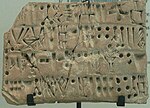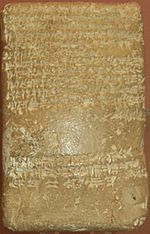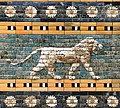Cuneiform TI or TÌL (Borger 2003 nr. ; U+122FE 𒋾) has the main meaning of "life" when used ideographically. The written sign developed from the drawing...
5 KB (541 words) - 11:41, 9 May 2023
Ti, a chemical element Truncated icosahedron Ti (concept), a term meaning "substance" (體) in Chinese TI (cuneiform), a sign in cuneiform writing Ti,...
3 KB (411 words) - 04:20, 17 May 2024
contains cuneiform script. Without proper rendering support, you may see question marks, boxes, or other symbols instead of cuneiform script. Cuneiform is a...
348 KB (10,291 words) - 20:45, 12 September 2024
used in the context "ti-rV". Thus "ti-ra" might be written with the glyphs for "tir" and "a" or "ti" and "ra". Elamite cuneiform allows for a lot of freedom...
12 KB (1,112 words) - 02:08, 8 August 2024
Luwian language (redirect from Cuneiform Luwian)
these names) are known after the scripts in which they were written: Cuneiform Luwian (CLuwian) and Hieroglyphic Luwian (HLuwian). There is no consensus...
39 KB (4,534 words) - 06:55, 12 September 2024
Sumero-Akkadian Cuneiform script is covered in three blocks in the Supplementary Multilingual Plane (SMP): U+12000–U+123FF Cuneiform U+12400–U+1247F Cuneiform Numbers...
117 KB (895 words) - 19:00, 10 September 2024
DNIN.TI. The compound form NIN.DINGIR ("divine lady" or "lady [of a] god"), denotes a priestess. NIN originated as a ligature of the cuneiform glyphs...
4 KB (412 words) - 08:45, 9 September 2023
Cuneiform is one of the earliest systems of writing, emerging in Sumer in the late fourth millennium BC. Archaic versions of cuneiform writing, including...
146 KB (534 words) - 15:10, 25 April 2024
The Tu-Ta-Ti scribe study tablets are tablets written in Cuneiform found all over Mesopotamia, used for a diverse set of languages, along a vast timespan...
6 KB (850 words) - 18:15, 29 June 2024
Hittites (redirect from Hittite cuneiform tablets)
article contains cuneiform script. Without proper rendering support, you may see question marks, boxes, or other symbols instead of cuneiform script. The Hittites...
97 KB (11,193 words) - 21:42, 5 September 2024
article contains cuneiform script. Without proper rendering support, you may see question marks, boxes, or other symbols instead of cuneiform script. This...
16 KB (1,460 words) - 16:47, 27 June 2024
Urartian language (section Cuneiform)
article contains cuneiform script. Without proper rendering support, you may see question marks, boxes, or other symbols instead of cuneiform script. Urartian...
46 KB (5,759 words) - 08:15, 31 July 2024
Akkadian language (category Cuneiform)
during the Akkadian Empire (c. 2334–2154 BC). It was written using the cuneiform script, originally used for Sumerian, but also used to write multiple...
96 KB (8,932 words) - 00:40, 28 August 2024
sites across Iran. It is thought to have developed from early cuneiform (proto-cuneiform) and consists of more than 1,000 signs. It is thought to be largely...
35 KB (4,059 words) - 10:56, 1 September 2024
Mitinti (Philistine: 𐤌𐤕𐤕 *Mītīt or *Matīt; Akkadian: mi-ti-in-ti and me-ti-in-ti) was the name of several Philistine kings in the 8th and 7th century...
4 KB (376 words) - 00:47, 6 June 2024
Wikimedia Commons has media related to Bi (cuneiform). The cuneiform bi sign, also pí, and used for other syllabic forms, as well as a sumerogram, is...
9 KB (418 words) - 10:51, 5 August 2023
language of Cameroon Ki (kana), a Japanese syllabic character Ki (cuneiform), a sign in cuneiform writing Gikuyu language, ISO 639-1 code:ki Ki (Korean surname)...
3 KB (384 words) - 03:18, 7 April 2024
The cuneiform di sign, also de, ṭe, ṭi, and sumerograms DI and SÁ is a common-use sign of the Epic of Gilgamesh, the 1350 BC Amarna letters, and other...
17 KB (539 words) - 18:27, 4 July 2022
Another list designed to teach students the basics of cuneiform writing is known as TU-TA-TI. In this list, which students wrote out sets of signs grouped...
28 KB (4,141 words) - 06:32, 9 June 2024
article contains cuneiform script. Without proper rendering support, you may see question marks, boxes, or other symbols instead of cuneiform script. This...
38 KB (3,556 words) - 18:14, 9 September 2024
Inūma(=enūma) naṣāru -- ) (10)--(-City-Irqata,.. ana šâšu!.... ) Paragraph I–Cuneiform score, Akkadian, English 1.Ṭup-pí an-nu-ú,.. ṭup-pí ___țuppu annû, – țuppu...
38 KB (2,204 words) - 05:29, 24 March 2023
Asia portal Sîn-lēqi-unninni (Akkadian: 𒁹𒀭𒌍𒋾𒀀𒅆 md30-TI-ER2) was a mašmaššu who lived in Mesopotamia, probably in the period between 1300 BC and 1000 BC...
4 KB (478 words) - 02:40, 21 May 2024
List of cities of the ancient Near East (redirect from URU (cuneiform))
or territory controlled by a city, e.g. 𒄡𒆳𒌷𒄩𒀜𒌅𒊭 LUGAL KUR URUHa-at-ti "the king of the country of (the city of) Hatti". The KI 𒆠 determinative...
15 KB (1,334 words) - 20:16, 6 September 2024
Sumerian language (category Cuneiform)
obscurity until the 19th century, when Assyriologists began deciphering the cuneiform inscriptions and excavated tablets that had been left by its speakers...
275 KB (32,386 words) - 20:14, 14 September 2024
Hurrian songs (or Hurrian Hymns) are a collection of music inscribed in cuneiform on clay tablets excavated from the ancient Amorite-Canaanite city of Ugarit...
24 KB (3,129 words) - 03:07, 29 August 2024
24 January 2023. Aderet, Ofer (20 January 2023). "Two 3,800-year-old Cuneiform Tablets Found in Iraq Give First Glimpse of Hebrew Precursor". Haaretz...
8 KB (793 words) - 06:39, 31 December 2023
hieroglyphs in Egypt. There is no demonstrable connection to Hittite cuneiform. Individual Anatolian hieroglyphs are attested from the second and early...
60 KB (1,625 words) - 23:23, 28 August 2024
pronunciation. This is due to the belief that the Urartians used the cuneiform symbol š to voice an s-sound, as opposed to representing the digraph sh...
7 KB (535 words) - 11:57, 13 September 2024
The cuneiform sign šum is a common-use sign of the Amarna letters, the Epic of Gilgamesh, and other cuneiform texts (for example Hittite texts). Linguistically...
5 KB (213 words) - 23:56, 23 June 2023


















